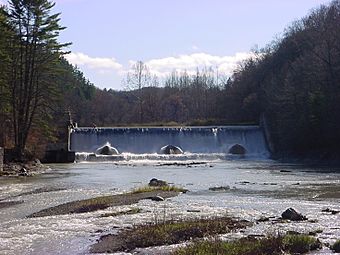Scoby Power Plant and Dam facts for kids
Quick facts for kids |
|
|
Scoby Power Plant and Dam
|
|

Scoby Power Plant and Dam, November 2009
|
|
| Location | Towns of Ashford / Concord, New York, USA |
|---|---|
| Nearest city | Springville, New York |
| Built | 1925 |
| Architect | Brass Bros. |
| Architectural style | Power Plant and Dam |
| NRHP reference No. | 96000296 |
| Added to NRHP | September 20, 1996 |
The Scoby Power Plant and Dam is an old dam and power plant. It is located between the towns of Ashford and Concord, near Springville, New York. This important site sits on the east side of Cattaraugus Creek.
It shows what a small hydroelectric (water-powered) electricity plant looked like in the early 1900s. The current buildings were built in 1925. They replaced an older power plant that was nearby. In 1996, the Scoby Power Plant and Dam was added to the National Register of Historic Places. This means it is a special place that is important to history.
Contents
Scoby Dam Park: A Place to Explore
The Erie County Department of Parks, Recreation and Forestry took over the dam and the land around it. This happened after the Village of Springville stopped using the dam to make power in 1998. The park is kept as a "conservation park." This means it has very few buildings or changes. It is mostly left natural.
The park is a popular spot for people who like to fish. They often look for steelhead trout during the fall, winter, and spring. The park also has areas where families can have picnics and places to go hiking. In 2014, people living nearby started asking for help from the state and local governments. They wanted to create the "Springville Whitewater Park" there. This new park would have special areas for whitewater rafting.
Future Plans for the Scoby Dam
There are ideas to change the Scoby Dam. People are worried about how strong the dam is. They also want to help fish, like steelhead, move more easily up the creek. The plan is to make the dam about 30 feet (9 meters) shorter. Right now, it is 38 feet (11.5 meters) tall.
The U.S. Army Corps of Engineers suggested this plan in 2014. It would cost about $6.6 million. If the plan is approved, the work could start within three years.
Helping Fish Move Upstream
Along with making the dam shorter, a 15-foot (4.5-meter) fish ladder would be built. A fish ladder helps fish swim around a dam. This would let fish travel an extra 44 miles (71 kilometers) up Cattaraugus Creek. It would also open up its smaller streams.
If steelhead can go beyond the dam, people who fish would have more places to go. They could fish in an extra 34 miles (55 kilometers) of public stream. Right now, only 4 miles (6.4 kilometers) of the stream below the dam are open for fishing.
There are good places for steelhead to lay their eggs (spawn) above the dam. If the dam is changed, more steelhead might be able to reproduce on their own. Currently, most steelhead in the creek are put there by people each year. However, about 25% of the steelhead already reproduce naturally.
Concerns About the Dam Project
Some people are worried about the plan. They think it might affect other fish, like brown and rainbow trout, that live above the dam. They also worry about bringing invasive species into parts of the creek that do not have them now. One concern is the sea lamprey.
The U.S. Army Corps of Engineers' plan includes special barriers. These barriers are designed to stop sea lampreys from moving past the dam.




